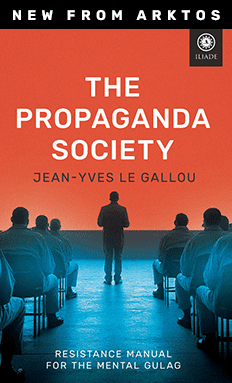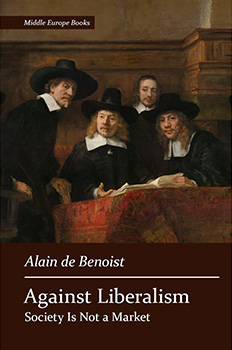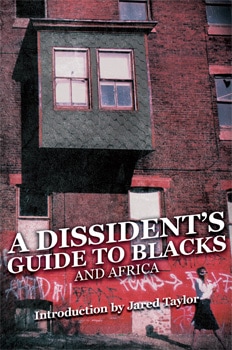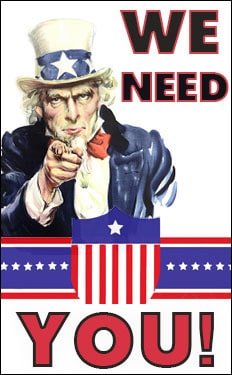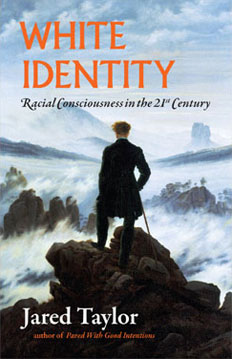Asian Consciousness
Jared Taylor, American Renaissance, Spring 2010
Editor’s Note: This is adapted from chapter seven of Jared Taylor’s book White Identity, available for purchase here.
Asian-Americans have long been known as the “model minority.” This is for two reasons. First, only a few Asian groups suffer from the social problems associated with blacks and Hispanics. Second, Asians have not made forceful demands on American society in the name of race. They have stayed away from identity politics and generally tried to assimilate.
The first of these reasons for being a “model” shows no sign of changing. With the exception of a few small groups such as the Hmong and certain Pacific Islanders, Asians continue to be hardworking, successful, and law-abiding. However, the past few decades have seen a marked increase in the willingness of Asians to band together across ethnic lines and to make demands in the name of race. Rather than trying to melt into the majority society as they did during the post-war period, Asians are beginning to adopt the tactics that other groups have shown to be successful. They are not nearly so focused on racial identity as blacks or Hispanics, but a group that showed every sign of downplaying the significance of race — of genuinely trying to assimilate — is now moving in the opposite direction.
No doubt this is partly explained by the increase in the number of Asians. When minority communities grow they exert a powerful attraction on their members that fosters parochial loyalties. At the same time, when other minorities turn their backs on assimilation and carve out alternative identities for themselves — and gain clear advantages from doing so — the temptation to do likewise is strong.
“Our parents told us don’t make a fuss, stay out of the public, eye,” explains Frank Wu, an Asian-American activist and law professor at Howard University, “but that advice serves no purpose in a diverse democracy.” It serves no purpose when every other group is making a fuss and pushing clearly ethnic interests.
The term “model minority” has been under attack for some time, but not from the people you might expect. It would be logical for blacks and Hispanics to object to the term, since it implies that they are less desirable minorities, but they are not the critics. It is the younger generation of Asians who now spurn a label that made their elders proud.
Who are the Asians?
Asians are still a small minority — at 13.4 million they are 4.4 percent of the population, according to the Census Bureau estimate of 2007 — but their impact is vastly disproportionate to their numbers. Forty-four percent of Asian-American adults have a college degree or higher, as opposed to only 24 percent of the general population. Asian men have median earnings 10 percent higher than non-Asian men, and that of Asian women is 15 percent higher than non-Asian women. Forty-five percent of Asians are employed in professional or management jobs as opposed to 34 percent for the country as a whole, and the figure is no less than 60 percent for Asian Indians.
The Information Technology Association of America estimates that in the high-tech workforce Asians are represented at three times their proportion of the population. Asians are also more likely than the American average to own homes rather than be renters. These successes are especially remarkable because no fewer than 69 percent of Asians are foreign-born, and immigrant groups have traditionally taken several generations to reach full potential.
It is a mistake, however, to paint all Asians with the same brush. Chinese (24 percent of the total) and Indians (16 percent) are extremely successful, as are Japanese and Koreans. Filipinos (18 percent) are somewhat less so, and the Hmong significantly less so. Hmong earn 30 percent less than the national average, and 60 percent drop out of high school. In the Seattle public schools, 80 percent of Japanese-American students passed Washington state’s standardized math test for 10th-graders — the highest pass rate for any ethnic group. The group with the lowest pass rate — 14 percent — was another “Asian Pacific Islanders” category: Samoans.
Different Asian nationalities can therefore have very distinctive profiles. For example, 40 percent of the manicurists in the United States are of Vietnamese origin and half the motel rooms in the country are owned by Asian Indians. On the whole, however, Asians have a well-deserved reputation for high achievement.
Asians are vastly overrepresented at the best American universities. Although less than 5 percent of the population, they account for the following percentages of the student bodies of these universities: Harvard: 17 percent, Yale: 13 percent, Princeton: 12 percent, Columbia: 14 percent, Stanford: 25 percent. In California, the state with the largest number of Asians, they made up 14 percent of the 2005 high-school graduating class but 42 percent of the freshmen on the campuses of the University of California system. At Berkeley, the most selective of all the campuses, the 2005 freshman class was an astonishing 48 percent Asian.
Asians are also the least likely of any racial or ethnic group to commit crimes. In every category, whether violent crime, white-collar crime, alcohol, or sex offenses, they are arrested at about one-quarter to one-third the rate of whites, who are the next-most law-abiding group. (The New Century Foundation report, The Color of Crime, found that Asians are many times more likely than whites to be members of youth gangs, so Asian crime rates may start climbing.) There is one exception: gambling. Chinese, in particular, are heavy gamblers but so are Vietnamese, Filipinos, Cambodians, and Koreans. Asians as a group are three to four times more likely than whites to be arrested for gambling offenses and a 1999 poll in San Francisco’s Chinatown found that 70 percent of respondents said gambling was the community’s number-one problem.
Asians are, in fact, such an important factor in the gambling business that after the MGM Grand Hotel & Casino opened in Las Vegas in 1993, it spent millions of dollars redesigning its entrance. It had been built to look like the mouth of a lion, the company’s logo, but many Asians would not enter the building because they thought it was bad luck to walk into the jaws of a beast.
Pan-Asian Identity
Asian immigrants started coming to the United States in the 1850s, and Asians have a rich history in North America. Like many other immigrant communities, they established self-help and other associations along national lines. These organizations fought discrimination but were mainly vehicles for mutual assistance, not the cultivation of a racial identity or the pursuit of political power. Recently, however, there is a clear tendency to establish broadly Asian organizations that are essentially expressions of racial solidarity.
Don Nakanishi, director of the UCLA Asian American Studies Center, explains that this is a burgeoning trend, especially in politics. What he calls a “pan-Asian” perspective is increasingly common, with Asians funneling money and votes to candidates who are of the same race but may be of a different national origin.
“A lot of it has to do with maximizing their political clout,” explains demographer William Frey. “They want to identify themselves as a pan-Asian group rather than segment themselves . . . It makes sense for Asians to band together.” It makes sense because there is strength in numbers and because race is a common bond.
OCA is the name of an influential Asian-American organization that grants scholarships only to Asian students and makes awards to outstanding Asian-American business executives. It was founded in 1973 as the Organization of Chinese Americans, but as part of its current pan-Asian emphasis, it is now known almost exclusively by its initials. When C.C. Yin, a San Francisco businessman, recently started an organization to nurture future political leaders, he did not limit it to Chinese, but called it the Asian Pacific Islander American Political Association.
Typical of the recent trend is a glossy magazine called AsianAm that was scheduled for launch in 2009. According to its mission statement, it was to be “the One Voice for all Asian cultures.” Likewise, when the Asian Real Estate Association of America opened a chapter in Las Vegas in 2008, its president, John Fukuda, noted that although Las Vegas has a section called Chinatown, “it’s really Asiatown.” Asians of all nationalities feel comfortable there.
There is no doubt that Asians are drawn to other Asians. Irvine, California, which used to be a typical white, conservative suburb, was 37 percent Asian in 2006, and has become a place where one need never speak English. Chinese are the most numerous Asian group, but Irvine also attracts Koreans, Japanese, and Vietnamese. Asians continue to increase in numbers and many schools have become heavily Asian. The University of California at Irvine (UCI) was 40 percent Asian in 2007 and sometimes jokingly referred to as the University of Chinese Immigrants.
Businesses have followed Asian communities, offering services in Asian languages and providing the comfort that comes from dealing with fellow ethnics. In 2006, two Chinese-oriented banks, Cathay General Bancorp and East West Bancorp were the second- and third-largest banks in Los Angeles County. Both started in Chinatown and moved out with their customers. Both were pursuing Asian customers in other states as well.
Asian identity seldom takes on the hostile, anti-white tone common with blacks and Hispanics, but it is not entirely absent. In 1997, Vietnamese-born Peter Nguyen was president of the UCLA Law School student bar association. To a suggestion that California had taken in too many immigrants, he replied, “Be warned: There is a lot of diversity here, and if you don’t like it, there are 49 other states and plenty of islands” to move to.
At about the same time, there were reports of Asians in high schools in Santa Clara County, California, who had joined gang-like groups called “Asian Pride.” They took collective revenge against slights from whites, did not socialize with whites, and harassed other Asians who did. They had an explicitly Asian identity, with a mix of members: Chinese, Japanese, Koreans, and Filipinos. This tendency does not, however, appear to be nearly so widespread or hard-edged as the racial identification of school-aged blacks and Hispanics.
In 2000, a Chinese-American named Carrie Chang started an angry magazine for Asians called Monolid. In language that seemed borrowed from black racial consciousness, the magazine urged all Asians to “rise up and grasp their identity” so as to fight “that ugly racism which is accosting us at every moment.” One of Miss Chang’s favorite themes was the need for Asian women to stop dating white men. About three-fourths of white-Asian marriages involve white men and Asian women, and according to C.N. Le, a Vietnamese-American who teaches sociology at the University of Massachusetts, “Some of the men view the women marrying whites as sellouts.”
Monolid took a more militant view. One article quoted Samuel Lin, a student at University of California at Berkeley, who deeply resented white men who dated Asians. “I think we should f — in’ kill them all,” he said. “Stick to your own flavor.” More significant than the aggressive tone of Monolid is the fact that it could not find a market. It lasted only a year or two.
Another representative difference between Asian and black identity can be found in Congress. There has been a Congressional Asian Pacific American Caucus since 1994, but unlike the black caucus, it admits non-Asians whose districts include large numbers of Asian-Pacific constituents. White representatives from Hawaii and Guam have been members.
The non-white mainstream
Asians are nevertheless joining the non-white mainstream when it comes to making demands in the name of race. In 2000, for example, Asian actors were complaining that they were underrepresented in casting decisions and that they were too often typecast as martial arts experts or seductresses. Counting right down to tenths of a percent, they argued that since they were 3.8 percent of the population, they deserved more than 2.2 percent of the television and movie roles. “We are depriving children of knowledge of the world we live in by not providing them with an accurate portrayal of the American scene,” said Chinese-American actor Jack Ong. Asian Week complained that in Hollywood movies “the heroic Caucasian protagonist saves the helpless people of color.”
Asians have also begun to act more like blacks and Hispanics on college campuses. In 2000, 100 Asian students demonstrated on the campus of the University of Illinois at Chicago, demanding establishment of an Asian-American studies program, an Asian cultural center, and a special academic support network for Asians. They were also furious because the university had put out a press release bragging it had received an award for supporting diversity — but had failed to mention Asians. “We will not tolerate being treated that way,” said Haley Nalik, president of the Coalition for Asian American Studies.
In California, which has by far the largest number of Asian university students, activists were frustrated by the assumption that Asians were doing well and did not need special assistance. They pointed out that Bangladeshis and Malaysians, as well as islanders from Guam and Tonga were underrepresented on campuses, and demanded that administrators stop pretending Asians as a group were successful. In what is becoming an increasingly typical pan-Asian approach, the overrepresented Asians, such as Chinese and Koreans, insisted that the smaller ethnicities be counted separately and be more aggressively recruited if they were underrepresented. In 2007, the University of California system agreed to start counting no fewer than 23 Asian and Pacific Islander categories to ensure than no one gets short shrift.
Increasingly, like “non-model” minorities, Asians keep a sharp eye out for perceived slights, as the Ladies Professional Golf Association (LPGA) discovered in 2008. Interviews, endorsements, socializing with sponsors, and professional-amateur rounds are important sources of revenue for the LPGA Tour, and organizers announced that players would not be allowed to compete if they did not speak English well enough to take part. Asian organizations immediately went on the offensive, and Asian-American state legislators in California threatened to pass a law that would ban such a policy in California. The LPGA quickly backed down. I’m pleased they have come to their senses,” said California assemblyman Ted Lieu.
In 2008, CNN commentator Jack Cafferty complained that China made “junk with lead paint” and exported “poisoned pet food,” and called Chinese leaders “basically the same bunch of goons and thugs they’ve been for the last 50 years.” This prompted throngs of Chinese to gather outside CNN offices in Hollywood to demand that he be fired. They sang the Chinese national anthem and waved Chinese and Taiwanese flags, in a demonstration that drew both mainland and Nationalist Chinese.
Joseph Groh, the owner of a popular Philadelphia restaurant, was proud of keeping things the way they were since the diner was founded in 1959 — the same soda fountain, ceiling fans, sparse menu, and wooden booths. Asians, however, were offended because he kept the restaurant’s original name — Chink’s — the nickname of the man who started it. For years, Asians pressured Mr. Groh to change the name, but he refused. In 2008, Asians succeeded in persuading a city agency to deny a lease for a second location. “We actually stopped it [the restaurant] from expanding,” said Tsiwen Law, general counsel of the Greater Philadelphia OCA. “Going outside of his neighborhood will be difficult, because we will respond,” he added.
In 2009, OCA also slammed the singer Miley Cyrus for what it claimed was gross insensitivity to Asians. A snapshot of the then-16-year-old taken with a group of friends showed her and several others pulling their eyes into a slanted position that is supposed to look Asian. A Los Angeles Asian-American, Lucie Kim, went even further, filing a civil rights claim for $4 billion in compensation for all Asian-Americans.
Actions of this kind, which have been staples of black and Hispanic activism, would have been unthinkable to Asian leaders of a generation ago.
Like the larger minorities, Asians are also beginning to push racial-ethnic interests in politics. Gautam Dutta is executive director of the Asian-American Action Fund. “Historically, they [Asians] are less focused on politics,” he says, “but they are an emerging bloc, suddenly in the last few years in both state and national elections.”
The California state legislature has had an Asian Pacific Islander Legislative Caucus since 2001, and it joined the black and Hispanic caucuses in threatening to cut off funding for the state judicial system if Gov. Arnold Schwarzenegger did not appoint more non-white judges. Caucus member Ted Lieu argued that it was manifestly unfair that although Asian-Americans made up 12.6 percent of the state’s population, they represented only 4.6 percent of the governor’s 260 judicial appointments. (He was unconcerned by the fact that the state bar, from which all appointments must come, was 85 percent white.) He also introduced legislation that would require the state to keep track of 21 different Asian ethnicities to make sure less successful groups were getting the attention they need. “To the extent that I can help out on issues statewide affecting Asian Pacific Americans, I’m going to try and do that,” he explained.
Some more-recently-arrived Asian groups are not yet at the pan-Asian level of organization and make narrowly ethnic political appeals. In 2007, two independent Vietnamese candidates set off what was called a “political earthquake” by beating both the Republican and Democratic candidates — one white, the other Hispanic — for a place on the powerful Orange County, California, Board of Supervisors. As the Los Angeles Times explained, the Vietnamese upset the favorites by clever use of absentee ballots and by “shrewdly courting ethnic loyalties.” Vietnamese were pleased. “All candidates should know by now they can’t win an election around here without the support of the Vietnamese community,” said Lan Nguyen, president of the Garden Grove Unified School District Board of Trustees.
That same year, the Orange County town of Westminster became the first in the nation to have a city council that was majority Vietnamese. They were not a majority of voters — under 40 percent — but they voted overwhelmingly for fellow ethnics while non-Vietnamese split their votes among a number of candidates. The county’s white and Hispanic politicians began translating campaign literature into Vietnamese and posing for photos with the yellow and red flag of the former country of South Vietnam — a gesture that appeals to those who fled the Communists. “I don’t believe in central Orange County you can be a successful elected official without the Vietnamese vote,” said state senator Louis Correa of Santa Ana, who hired Vietnamese-American staffers and even took part in a hunger strike to protest human rights abuses in Vietnam.
Some Asian office-holders, however, are discovering the limits of single-ethnicity politics. In San Jose, California, Madison Nguyen became the standard bearer for the Vietnamese community when she was elected in 2006 to the city council on the strength of a massive ethnic vote. Three years later she was fighting for her political life after Vietnamese voters — 30 percent of the electorate — turned on her because she would not stick to a narrowly Vietnamese agenda. “I can’t say yes all the time,” she said. “I’m not just a daughter in the Vietnamese-American community alone.” Vietnamese voters felt betrayed. Her opponents put a recall petition on the ballot, but in March 2009, Miss Nguyen kept her seat with 55 percent of the vote.
Asian Indians are organizing politically as well. Approximately one-third of the population of the New York City suburb of Edison is Indian, and politicians take notice. Sikhs have won election to low-level offices in New York City, and the Sikh Coalition managed to get a bill pending in the city council to allow city employees to wear turbans. The American Association of Physicians of Indian Origin is now the biggest doctors’ group in the nation after the American Medical Association.
At the pan-Asian level, the most successful political force is probably the 80-20 initiative, established in 1998 with the aim of delivering a massive Asian vote — 80 percent of it — to candidates who agree to its demands. Its founders include S.R. Woo, former lieutenant governor of Delaware, and Chang-lin Tien, former chancellor of UC Berkeley, hardly people who failed to get a foothold in the mainstream.
National politicians take 80-20 seriously. During the 2004 presidential elections, nine of the 11 candidates, including John Kerry, John Edwards, Howard Dean, Joseph Lieberman, and Dennis Kucinich, signed an 80-20 statement saying that if elected they would order the Labor Department to hold public hearings on discrimination against Asians, and would meet with Asian leaders to discuss progress in combating such discrimination.
For the 2008 election, Chris Dodd, Joe Biden, and Mike Gravel agreed to the 2004 pledge but went further, promising to appoint enough Asian-American judges to triple their number on the bench and to consider appointing an Asian to the Supreme Court. John Edwards, Bill Richardson, and Hillary Clinton signed a statement agreeing to keep appointing Asians “until the current dismal situation is significantly remedied.” “What is the secret that 80-20 can get such perfect answers from presidential candidates?” asked the 80-20 website. “Its ability to deliver a bloc vote!” More and more politicians are finding that Asians are yet another pressure group whose demands must not be ignored.
Asians have many interests they want their representatives to push — celebration of Asian holidays, open immigration policies, foreign-policy considerations — but one of the most consistent is that Asians be included in minority set-asides for government contracting. The fact that most Asian groups are economically more successful than non-Asians does not reduce their enthusiasm for these programs.
For many Asian Americans, especially Chinese Americans, the Wen Ho Lee spying case pushed them decisively in the direction of racial consciousness. Mr. Lee is a Taiwan-born scientist who became a naturalized US citizen and worked at the Los Alamos National Laboratory. In 1999, he was accused of spying for China and was held for nine months in solitary confinement during an investigation.
The case never came to a conclusion, partly because the New York Times leaked his identity and the resulting coverage derailed the investigation. Espionage charges were withdrawn as part of a plea bargain, in which Mr. Lee confessed to one felony count of improperly downloading classified information to unsecured computers. He never gave a plausible explanation for why he needed this information. It also came to light that Chinese authorities had asked him to spy for them, and he had violated regulations by not reporting this.
The federal judge who handled the case pointed out to Mr. Lee that he had plead guilty to a serious crime but he also apologized for prosecutorial misconduct. Mr. Lee eventually won a judgment of $1.6 million from the US government and five different media companies because his identity as a suspect had been leaked.
It is a murky case, and certainly appears to have been mishandled by the government, but many Asian organizations were convinced it was a case of pure racial profiling. Asian Week wrote about Mr. Lee’s “martyrdom,” and charged that Asians had been “singled out and looked upon with suspicion.” Albert Wang, a California doctor who championed Mr. Lee, called his prosecution “the major Chinese-American civil rights case in the last 30 years.” Karen Narasaki, executive director of the National Asian Pacific American Legal Consortium called Mr. Lee’s case a “watershed.” “This community [Asians] bought into the notion that if you work hard, pay attention to your family, you will be accepted,” she said. “This case says it’s not true.”
Supporters created the Wen Ho Lee Defense Fund and raised $100,000 for his legal bills. The Association for Asian American Studies and a group called Asian Pacific Americans in Higher Education called on all Asian Americans to refuse to work for federal nuclear laboratories. They argued that because Asians and Asian Americans account for a quarter of all doctorates awarded in the US in science and technology, a boycott would seriously hurt the labs.
In 2004, four years after the plea bargain, the Asian legislative caucus in the California state house announced it would publicly honor Mr. Lee with a “profiles in courage” award. It backed down after a furious reaction from what Mr. Lee’s supporters called “racist, right-wing zealots.”
Nearly 10 years after charges were initially filed, Chinese-Americans were still angry about the Lee case, and fought President-elect Barack Obama’s choice of former New Mexico governor Bill Richardson as commerce secretary. Mr. Richardson was energy secretary at the time of the Lee accusations and had cabinet-level responsibility for Los Alamos. Asian Week was convinced Mr. Richardson had encouraged the prosecution exclusively for racial reasons: “It was a de facto APA [Asian Pacific Islander] witch-hunt set off by Richardson’s green light: the xenophobic targeting of Lee as a spy . . . Richardson found a way to use fear of Asians to whip up hysteria against Asian Americans not seen since World War II.”
Mr. Richardson withdrew his nomination because of an investigation into business dealings as governor of New Mexico. Had he not done so, Asian groups would have tried to stop his appointment, even if it meant angering Hispanics, who strongly favored Mr. Richardson.
The case certainly raised sensitive questions. Is it possible Mr. Lee could have been tempted to spy for China because of a feeling of kinship? It is well known that, loyalties, whether national, ethnic, or racial are deeply emotional.
On some occasions, Chinese living in North America have not been shy about expressing their deepest loyalties. In 1999, the American women’s soccer team met the Chinese team in Los Angeles for the finals of the Women’s World Cup. Los Angeles has long had large Chinese communities from Taiwan, Hong Kong, and the mainland that felt little love for each other, but they set aside their differences to root with one voice for the Chinese team. “There are political differences, but because the team is Chinese, that’s all we think about,” explained Louis Wong, a Chinatown news vendor who came from Hong Kong.
Two groups that did not ordinarily get along — the Chinese consulate and conservative Chinese business organizations — joined forces to buy seats in the same section so thousands of Chinese-American fans could sit together and make a tremendous din for the Beijing team. The idea that Chinese might have come together to root for their new homeland would have been laughable. “I’m a US citizen, but I’m Chinese,” explained businessman Edward Chang.
When China hosted the Olympic Games in 2008 the sentiment of Canadian-Chinese was much the same. Andrea Chun, a Toronto lawyer and television host, explained that “when it comes to the games, most Chinese-Canadians are rooting for China, to be honest,” adding, “They won’t admit it if you ask them, but for sure they are.” Rich Chan, a personal trainer who had lived his entire life in Canada was happy to admit it. “I’m going with China. China all the way,” he said.
Athletic teams represent nations in contests that have decisive, win-or-lose outcomes. International athletics therefore feed many of the emotions aroused by war. In Los Angeles, Chinese-Americans did their best to give the Beijing team a home-field advantage when it played the American team. Would it be so surprising if some of the thousands who cheered the Chinese team expressed their loyalty in other ways? Is it wrong to wonder if they might?
China is hungry for American technology, and devotes a major part of its huge espionage effort to the United States. The Chinese method of spying is different from that of the classic, Soviet technique of sending trained professionals to burrow deep into enemy infrastructure. Beijing gets intelligence from thousands of part-time and amateur spies: students, businessmen, and Chinese citizens of target countries. According to the US government Intelligence Threat Handbook, 98 percent of the Americans the Chinese approach for information are Chinese-Americans: “Ethnic targeting to arouse feelings of obligation is the single most distinctive feature of PRC intelligence operations.”
According to a joint FBI/CIA report, “When approaching an individual of Chinese origin, the Chinese intelligence services attempt to secure his or her cooperation by playing on this shared ancestry.” David Szady, chief of FBI counterintelligence operations explained that Chinese spies “don’t consider anyone to be American-Chinese. They’re all considered overseas Chinese.” He noted that the politically correct pretense that American citizens never fall for this appeal interferes with the FBI’s counterespionage work.
Actual arrests, which, according to government sources, “are just the tip of the iceberg of an already-large and increasingly capable PRC [Peoples Republic of China] intelligence effort,” show that some Chinese-Americans are, indeed, susceptible to racial-nationalist appeals. In 2004, seven officers and employees of two New Jersey companies were arrested for transferring sensitive information on radar, smart weapons, and electronic warfare to Chinese government research institutes. The presidents of Universal Technologies and Manten Electronics were among the seven. Five were naturalized Chinese-Americans and the other two were permanent-resident Chinese.
Likewise in 2004, Ting-Ih Hsu, a naturalized US citizen and president of Azure Systems, pleaded guilty in Orlando, Florida, to exporting to China low-noise amplifier chips used in Hellfire missile systems. Also pleading guilty was Hai Lin Nee, a Chinese citizen and an employee of Azure Systems.
In 2005, Chi Mak, a naturalized Chinese American who held a “secret” level security clearance, was arrested for stealing classified details of submarine propulsion systems from his employer, Power Paragon, of Anaheim, California. His wife and a number of other family members helped him copy the information and deliver it to China. Mr. Mak was convicted in 2007 and sentenced to 241⁄2 years in prison in 2008. Also in 2005, Zhao Xin Zhu was sentenced in Boston to two years in prison and three years of supervised release after pleading guilty to trying to send night vision equipment and satellite technology to China. That same year, Jinghua and Xiuwen Liang, both naturalized citizens living in Thousand Oaks, California, were sentenced to 21⁄2 years imprisonment for exporting parts of F-14 fighters and various missile systems to China.
Likewise in 2005, naturalized citizens Ning Wen and his wife, Hailin Lin, were arrested in Wisconsin for smuggling electronics for use in missiles and radar systems. In 2006, Mr. Wen was sentenced to five years in prison and ordered to pay a $50,000 fine.
In 2006, Xiangdong Sheldon Meng, a naturalized US citizen living in Cupertino, California, was arrested for stealing night vision training software from a Silicon Valley defense contractor and trying to sell it to military buyers in Thailand, Malaysia, and China. That same year Fei Ye, a naturalized US citizen, and Ming Zhong, a permanent US resident, pleaded guilty to stealing civilian chip technology from Silicon Valley firms for delivery to China.
In February 2007, China-born, naturalized citizen Hanjuan Jin of Schaumburg, Illinois, was stopped at Chicago’s O’Hare airport with a one-way ticket to Peking, $30,000 in cash, and an estimated $600 million worth of trade secrets stolen from Motorola and another Chicago-area electronics firm, Lemko. In March 2008, she was charged with stealing trade secrets to take to China.
In 2008, the president of a Virginia-based high-tech company, Quan-Sheng Shu, pleaded guilty to selling rocket technology to China. A naturalized citizen, he was fined $400,000 and received a sentence of four years and three months. Likewise in 2008, naturalized citizen Tai Shen Kuo pleaded guilty in Alexandria, Virginia to selling data on Taiwan’s air defenses to China.
In February 2009, Yaming Nina Qi Hanson of Maryland was caught trying to take flight controls for miniature reconnaissance planes to China. She said she wanted to help China in its development efforts.
In July 2009, a federal judge found Dongfan “Greg” Chung guilty of delivering space shuttle secrets to China. Since 1973, when he started work at Rockwell International, he had stored more than 300,000 pages of secret documents in his home. “Mr. Chung has been an agent of the People’s Republic of China for over 30 years,” Judge Cormac Carney wrote, and noted that the naturalized US citizen “proudly proclaimed [China] as his “motherland’.”
Other Asian-Americans have been disloyal. Robert Kim, a naturalized citizen from South Korea who worked as an intelligence analyst for the Navy, was arrested in 1996 for turning over classified information to the South Korean Embassy. In an interview in 2004 after he was released from seven years in jail, he claimed to love America, his “adopted country,” but in an interview published in a South Korean paper he said he considered himself Korean first and foremost. Korean supporters called him a true patriot.
There is no official count of the number of Chinese-Americans who have been convicted of spying or helping the Chinese arms industry but there must be scores of them. Only Wen Ho Lee ever became a cause célèbre or prompted accusations of racial profiling. Was he really the victim of an anti-Asian witch hunt or was he a spy whose investigation was bungled? Whatever his supporters may say, racial and national ties are strong, and American counterespionage efforts must take them into consideration.
Clearly, only a small number of Asian-Americans are spies for China. However, there can be no doubt that Asians are more likely to spy for China than are non-Asians, and if they are going to be spies they are far more likely to spy for an Asian country than for Russia, for example. National bonds are strong.
This is not to place special blame on Asians. If Mexico were trying to develop sophisticated weapons and Mexican-Americans were in a position to help them, they would probably be just as active as Asians. Indeed, if roles were reversed, whites would probably be just as likely to be disloyal citizens of Asian nations. Questions of loyalty are always a problem in heterogeneous nations and security breaches will always be more common in such a nation than in one that is homogeneous.
At the same time, the very diversity of the United States and the openly parochial identities of so many non-whites have encouraged Asian Americans to reverse course on the road to assimilation. They are a group that at one time made great efforts to assimilate, but as blacks, Mexicans, and other Hispanics cultivate distinctive identities — and win political power, cultural recognition, and “affirmative action” benefits by doing so — why should Asians remain the “model minority” that does not try to thrust itself forward? It is no wonder that younger Asians now reject a label their elders worked to earn.
The Japanese-American poet Amy Uyematsu, who was born after the war, criticized her parents’ and grand-parents’ generations for trying to gain acceptance by “denying their yellowness” and complained that they were “white in every respect but color.”
Bill Seki, a Los Angeles lawyer born in the early 1960s, takes a similar view. He says his Japanese-American parents tried very hard to assimilate, to become “Americans first,” but the result was that “people take Japanese Americans for granted.” Mr. Seki does not want to be taken for granted. Instead, he says: “One comment you commonly get is, ‘You’re just like another white guy.’ No, that’s completely wrong.”
Presumably Mr. Seki’s parents would have considered it high praise to be thought no different — and treated no differently — from whites, but that view is passé. Race or ethnicity now comes before a larger American identity. The one racial group in addition to whites that at one time seemed committed to transcending race is moving away from that commitment.





